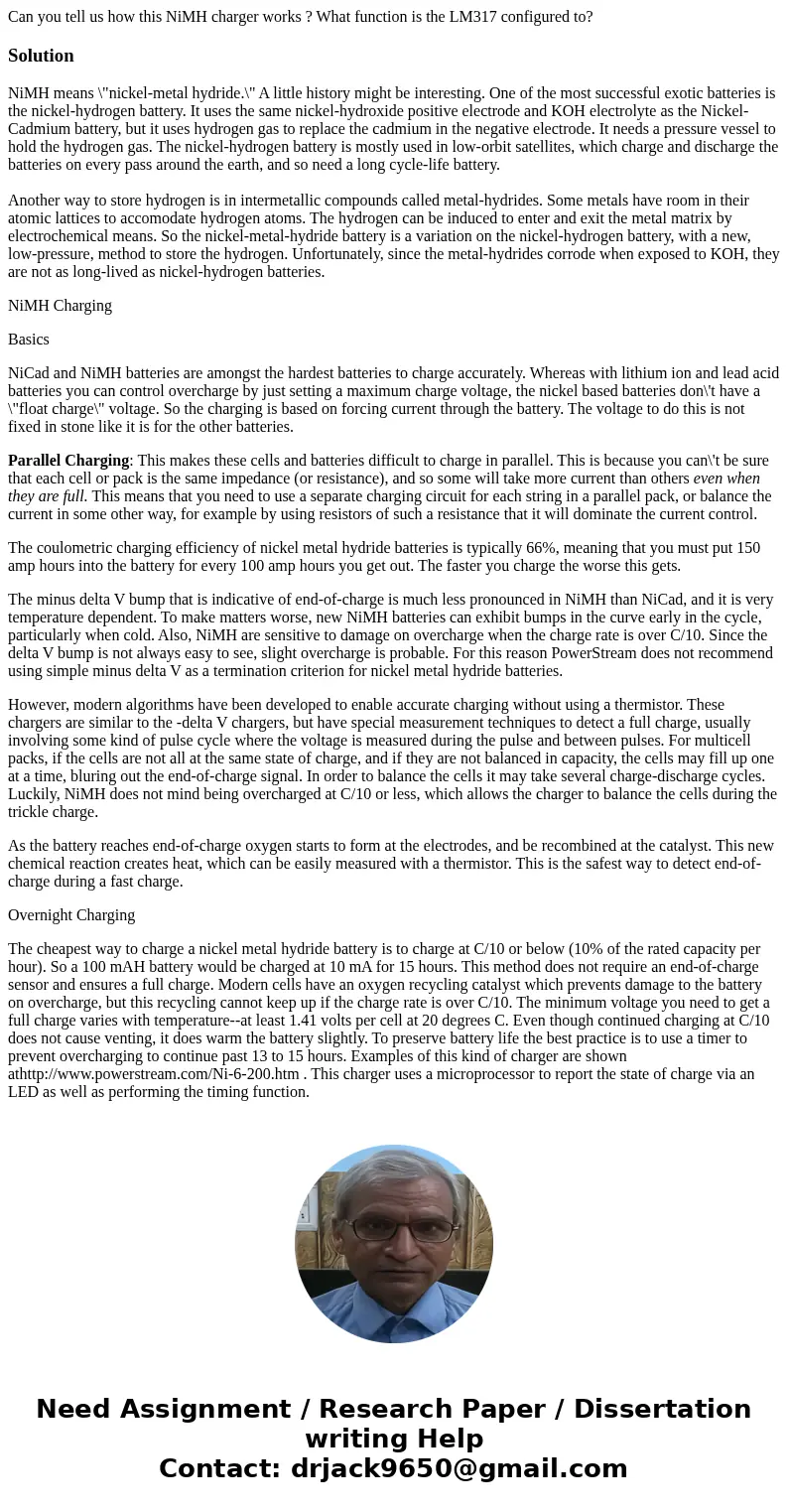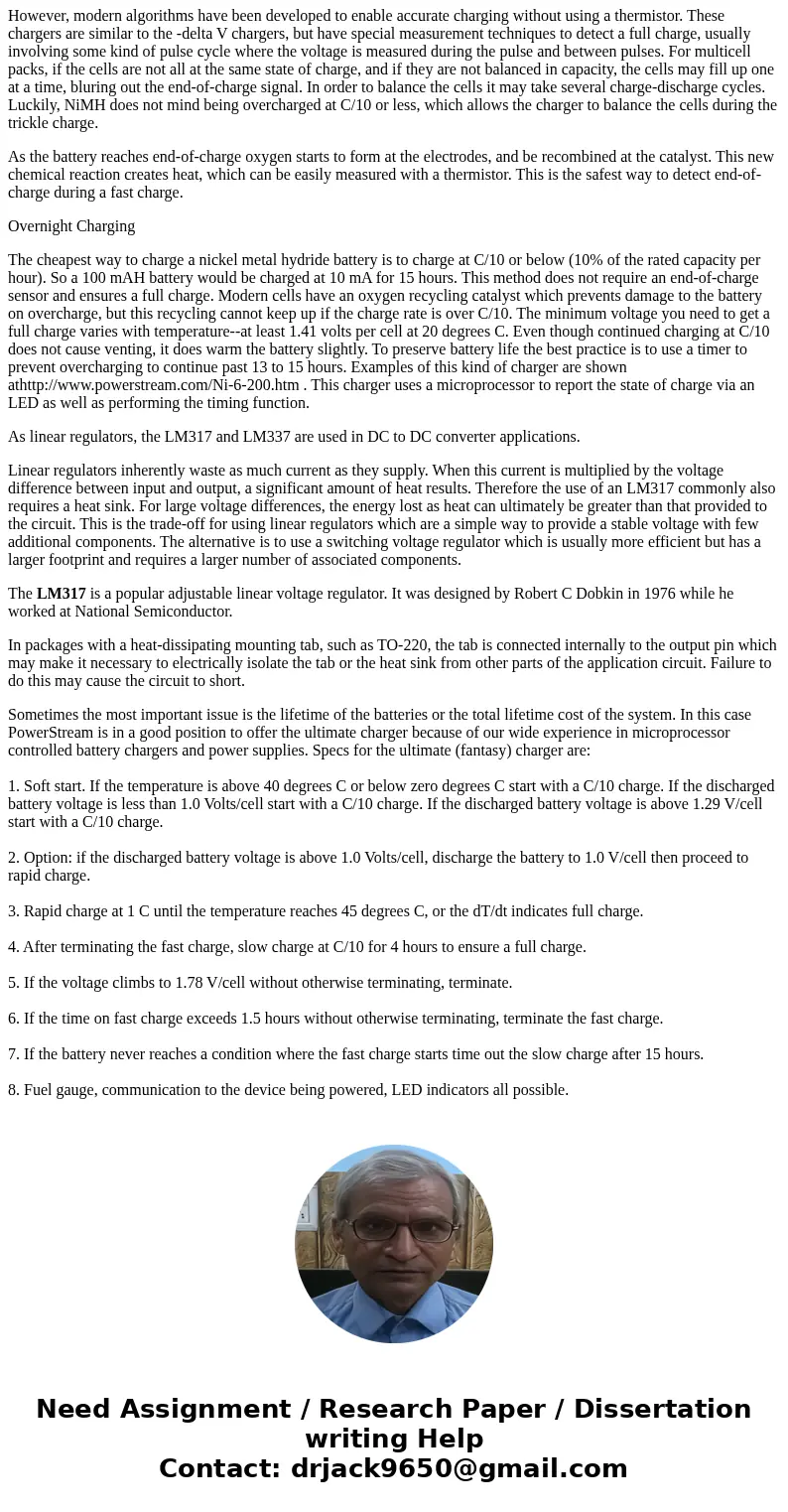Can you tell us how this NiMH charger works What function i
Can you tell us how this NiMH charger works ? What function is the LM317 configured to?
Solution
NiMH means \"nickel-metal hydride.\" A little history might be interesting. One of the most successful exotic batteries is the nickel-hydrogen battery. It uses the same nickel-hydroxide positive electrode and KOH electrolyte as the Nickel-Cadmium battery, but it uses hydrogen gas to replace the cadmium in the negative electrode. It needs a pressure vessel to hold the hydrogen gas. The nickel-hydrogen battery is mostly used in low-orbit satellites, which charge and discharge the batteries on every pass around the earth, and so need a long cycle-life battery.
Another way to store hydrogen is in intermetallic compounds called metal-hydrides. Some metals have room in their atomic lattices to accomodate hydrogen atoms. The hydrogen can be induced to enter and exit the metal matrix by electrochemical means. So the nickel-metal-hydride battery is a variation on the nickel-hydrogen battery, with a new, low-pressure, method to store the hydrogen. Unfortunately, since the metal-hydrides corrode when exposed to KOH, they are not as long-lived as nickel-hydrogen batteries.
NiMH Charging
Basics
NiCad and NiMH batteries are amongst the hardest batteries to charge accurately. Whereas with lithium ion and lead acid batteries you can control overcharge by just setting a maximum charge voltage, the nickel based batteries don\'t have a \"float charge\" voltage. So the charging is based on forcing current through the battery. The voltage to do this is not fixed in stone like it is for the other batteries.
Parallel Charging: This makes these cells and batteries difficult to charge in parallel. This is because you can\'t be sure that each cell or pack is the same impedance (or resistance), and so some will take more current than others even when they are full. This means that you need to use a separate charging circuit for each string in a parallel pack, or balance the current in some other way, for example by using resistors of such a resistance that it will dominate the current control.
The coulometric charging efficiency of nickel metal hydride batteries is typically 66%, meaning that you must put 150 amp hours into the battery for every 100 amp hours you get out. The faster you charge the worse this gets.
The minus delta V bump that is indicative of end-of-charge is much less pronounced in NiMH than NiCad, and it is very temperature dependent. To make matters worse, new NiMH batteries can exhibit bumps in the curve early in the cycle, particularly when cold. Also, NiMH are sensitive to damage on overcharge when the charge rate is over C/10. Since the delta V bump is not always easy to see, slight overcharge is probable. For this reason PowerStream does not recommend using simple minus delta V as a termination criterion for nickel metal hydride batteries.
However, modern algorithms have been developed to enable accurate charging without using a thermistor. These chargers are similar to the -delta V chargers, but have special measurement techniques to detect a full charge, usually involving some kind of pulse cycle where the voltage is measured during the pulse and between pulses. For multicell packs, if the cells are not all at the same state of charge, and if they are not balanced in capacity, the cells may fill up one at a time, bluring out the end-of-charge signal. In order to balance the cells it may take several charge-discharge cycles. Luckily, NiMH does not mind being overcharged at C/10 or less, which allows the charger to balance the cells during the trickle charge.
As the battery reaches end-of-charge oxygen starts to form at the electrodes, and be recombined at the catalyst. This new chemical reaction creates heat, which can be easily measured with a thermistor. This is the safest way to detect end-of-charge during a fast charge.
Overnight Charging
The cheapest way to charge a nickel metal hydride battery is to charge at C/10 or below (10% of the rated capacity per hour). So a 100 mAH battery would be charged at 10 mA for 15 hours. This method does not require an end-of-charge sensor and ensures a full charge. Modern cells have an oxygen recycling catalyst which prevents damage to the battery on overcharge, but this recycling cannot keep up if the charge rate is over C/10. The minimum voltage you need to get a full charge varies with temperature--at least 1.41 volts per cell at 20 degrees C. Even though continued charging at C/10 does not cause venting, it does warm the battery slightly. To preserve battery life the best practice is to use a timer to prevent overcharging to continue past 13 to 15 hours. Examples of this kind of charger are shown athttp://www.powerstream.com/Ni-6-200.htm . This charger uses a microprocessor to report the state of charge via an LED as well as performing the timing function.
As linear regulators, the LM317 and LM337 are used in DC to DC converter applications.
Linear regulators inherently waste as much current as they supply. When this current is multiplied by the voltage difference between input and output, a significant amount of heat results. Therefore the use of an LM317 commonly also requires a heat sink. For large voltage differences, the energy lost as heat can ultimately be greater than that provided to the circuit. This is the trade-off for using linear regulators which are a simple way to provide a stable voltage with few additional components. The alternative is to use a switching voltage regulator which is usually more efficient but has a larger footprint and requires a larger number of associated components.
The LM317 is a popular adjustable linear voltage regulator. It was designed by Robert C Dobkin in 1976 while he worked at National Semiconductor.
In packages with a heat-dissipating mounting tab, such as TO-220, the tab is connected internally to the output pin which may make it necessary to electrically isolate the tab or the heat sink from other parts of the application circuit. Failure to do this may cause the circuit to short.
Sometimes the most important issue is the lifetime of the batteries or the total lifetime cost of the system. In this case PowerStream is in a good position to offer the ultimate charger because of our wide experience in microprocessor controlled battery chargers and power supplies. Specs for the ultimate (fantasy) charger are:
1. Soft start. If the temperature is above 40 degrees C or below zero degrees C start with a C/10 charge. If the discharged battery voltage is less than 1.0 Volts/cell start with a C/10 charge. If the discharged battery voltage is above 1.29 V/cell start with a C/10 charge.
2. Option: if the discharged battery voltage is above 1.0 Volts/cell, discharge the battery to 1.0 V/cell then proceed to rapid charge.
3. Rapid charge at 1 C until the temperature reaches 45 degrees C, or the dT/dt indicates full charge.
4. After terminating the fast charge, slow charge at C/10 for 4 hours to ensure a full charge.
5. If the voltage climbs to 1.78 V/cell without otherwise terminating, terminate.
6. If the time on fast charge exceeds 1.5 hours without otherwise terminating, terminate the fast charge.
7. If the battery never reaches a condition where the fast charge starts time out the slow charge after 15 hours.
8. Fuel gauge, communication to the device being powered, LED indicators all possible.


 Homework Sourse
Homework Sourse